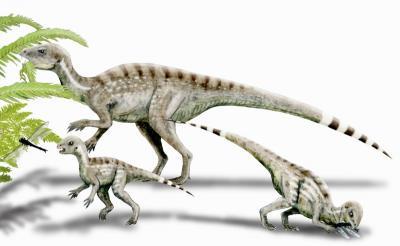'Tiny' dinosaur fossils
A group of scientists from London, Cambridge and Chicago recognized and described one of the smallest dinosaur skulls ever discovered. This skull is about 45 millimeters long and belongs to a very small Heterodontosaurus dinosaur. Animals weighing only about 200 grams.
On the number of autumns, Vertebrate Paleontology magazine, researchers describe important findings from the aforementioned skull showing how and when ornithischians, herbivorous dinosaurs include Heterodontosaurus, transforming habits from eat meat to eat plants.
Co-author Laura Porro, a doctoral student at the University of Chicago, said: 'It is possible that all dinosaurs evolved from ancestors eating meat. Because Heterodontosaurus is one of the first plant-eating dinosaurs, they can provide information about the transition from meat-eating ancestors to descendants eating plants'.
She added: 'This skull shows that the dinosaurs at that time were still in transition.'
Heterodontosaurus lived in the early Jurassic period ( about 190 million years ago ) in South Africa. Adult Peterodontosaurus is about the size of a turkey, has a length of 3 minutes and weighs about 5 to 6 pounds .
Because their fossils are rare, knowledge of Heterodontosaurus and its relatives is limited compared to later dinosaur groups.
Porro, who is working on a doctoral thesis under the guidance of David Norman, a Cambridge University researcher and author of the study, said: 'There are only two fossils of the Heterodontosaurus dinosaur. mature in South Africa. There have been rumors of a young Heterodontosaurus skull fossil in the South African Museum, but no one has mentioned it. '
Porro went to Iziko South Africa Museum, Cape Town, to examine the adult dinosaur fossils. There, she examined the museum's collection. She discovered two more heterdontosaur fossils, including the skull of a baby dinosaur, in materials found during excavations in 1960.

Teeth show that Heterodontosauru is an omnivorous species: canines are used to protect or add small animals such as insects to diets mainly plants.(Photo: Museum of natural history)
She said: 'At first I didn't realize it was a dinosaur fossil. When I turn it over, I see two eyes looking straight at me, I know exactly what I am holding. '
The main author of the study, Richard Butler of the Historical Reserve in London, said: 'This discovery is important because this is the first time we can study Heterodontosaurus' development process. Child Heterodontosaurus dinosaurs have fairly large eyes and short nose compared to adult dinosaurs. These differences are similar to what we see between puppies and adult dogs. '
As an expert on feeding mechanism, Porro is particularly concerned about the teeth.Heterodontosaurs have a rather strange set of teeth, with large fangs in the front jaw and blunt molars in the back . The teeth of most reptile animals change only slightly along the length of the jaw.
This strange set of teeth created arguments about Heterodontosaurus' food. Some scientists argue that Heterodontosaurus is omnivorous, that they use their multiple-shaped teeth to eat both plants and small animals. Others argue that heterodontosaurus is herbivores and fangs are a manifestation of sex - appearing only in males, like boars in this day. In that case, canines can be used as weapons when disputing a partner or territory.
Porro and colleagues noticed that the small dinosaurs had fully developed canines.
Butler said: 'The fact that the canines appear early suggests that it is not a sex expression because such traits often appear in later stages.'
Researchers believe that fangs are used as self-defense weapons against predators, or to occasionally add small animals such as worms, small mammals or reptiles to meals. mainly plants - a phenomenon that scientists call 'omnivorous'.
However, research also creates a new mystery. With the help of X-ray and CT scanners, Porro found no change in the teeth of adult dinosaurs and baby dinosaurs.
Most reptiles, including today's lizards and crocodiles, and dinosaurs change their teeth many times in their lives, so they always have sharp teeth. In contrast, most mammals replace once in a lifetime, allowing upper and lower teeth to develop into a tight and complete set of teeth.
Heterodontosaurus seems more like a mammal, not only in the shape of many teeth, but also in the characteristics of slow tooth replacement. The authors concluded: 'Tooth replacement appeared during the development phase, however, there is no evidence of tooth replacement in both adult dinosaur specimens and baby dinosaurs'.
The research was funded by the Royal Society, Cambridge University, and the Gates Cambridge Trust Foundation.
- 92 million year fossils from the tiny relative of the tyrant dinosaur
- 110 million year old dinosaur fossils
- The dinosaur fossil is about the size of a chicken
- Repeatedly discovered dinosaur fossils in Canada
- New dinosaurs have tiny arms
- Discover tiny tiny dinosaurs with Jurassic hair
- Found small dinosaur fossils like
- Close up of the world's largest dinosaur park
- Can the gender of dinosaur fossils be determined?
- Fossils alter the perception of feather dinosaurs
- Dinosaur park is only in imagination
- Discover dinosaur fossils like real Loch Ness monsters
 Discovered an ancient centipede fossil 99 million years old
Discovered an ancient centipede fossil 99 million years old Discovered bat-like dinosaurs in China
Discovered bat-like dinosaurs in China Discovered a 200-year-old bronze cannon of the coast
Discovered a 200-year-old bronze cannon of the coast Discover 305 million-year-old spider fossils
Discover 305 million-year-old spider fossils